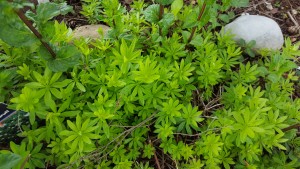 I love herbs that have multiple uses, especially if they can be used in the landscape in addition to any culinary or other uses. Sweet Woodruff (Galium odoratum) is an ideal multi use plant. It is a low, mat forming plant that makes an excellent groundcover, especially under trees. It is one of those rare herbs that likes shade. In fact, it prefers shade. Its leaves have a pleasant fragrance that has been variously described as smelling like honey, vanilla and even new-mown hay. The scent intensifies after the foliage has been dried which can then be used in potpourri. In medieval times, people took advantage of its pleasant scent and used sweet woodruff as a strewing herb, to mask the rank odors of indoor living spaces.
I love herbs that have multiple uses, especially if they can be used in the landscape in addition to any culinary or other uses. Sweet Woodruff (Galium odoratum) is an ideal multi use plant. It is a low, mat forming plant that makes an excellent groundcover, especially under trees. It is one of those rare herbs that likes shade. In fact, it prefers shade. Its leaves have a pleasant fragrance that has been variously described as smelling like honey, vanilla and even new-mown hay. The scent intensifies after the foliage has been dried which can then be used in potpourri. In medieval times, people took advantage of its pleasant scent and used sweet woodruff as a strewing herb, to mask the rank odors of indoor living spaces.
Sweet woodruff is also edible. Its most well-known use is as an ingredient in May wine, traditionally drunk on the first day of May to both welcome spring and as a healthful spring tonic. It has also been used to flavor other wines, as well as brandies, fruit salads, sorbets and jellies.
Sweet woodruff is a perennial that is native to most of Europe, Asia and Japan. It has also become naturalized in the northern US and southern Canada after it was introduced by European colonitsts. It can be grown in zones 3 through 8. Although it is evergreen in the south it struggles in the hotter summers. The plants grow 8 to 12 inches tall and spread via underground stolens. They can become invasive so they are best grown in dry shade where they will not spread as much. The foliage is deer resistant. The small, star shaped flowers appear in late spring and also are rabbit resistant. The resulting fruit has tiny hooks on it that catch on the fur of animals who the transport them to new areas where the seeds can grow into new plants.
Sweet woodruff can be propagated by division, cuttings or seed. Cuttings should be taken in the fall and rooted in pots or flats over heat mats to be planted in the spring. You can also dig up clumps of the plants in either the spring or the fall and transplant them to the area where you wish to start new plants. Plant the divisions about 12 inches apart and keep them well-watered until they have become established.
You can direct sow seeds in our garden in the spring or late summer. Barely cover them with soil and keep them watered until they germinate. You will most likely achieve very irregular germination with direct sown seed because the seed benefits from a period of cold stratification. For best germination, start your seeds indoors 10 weeks before your last frost date. Barely cover the seeds and gently water them. Cover your pots or flats with plastic bags and place them in the refrigerator for two weeks. Then move them to a cool place. Germination should occur within 4 to 6 weeks after cold treatment. You can transplant your seedlings into your garden when they have several sets of true leaves and after all danger of frost. Space them 12 inches apart.
For best fragrance, sweet woodruff leaves should be harvested right after the plants have bloomed. Cut the branches and tie them in bunches. Hang the bunches in a dark, cool, dry spot to dry.

